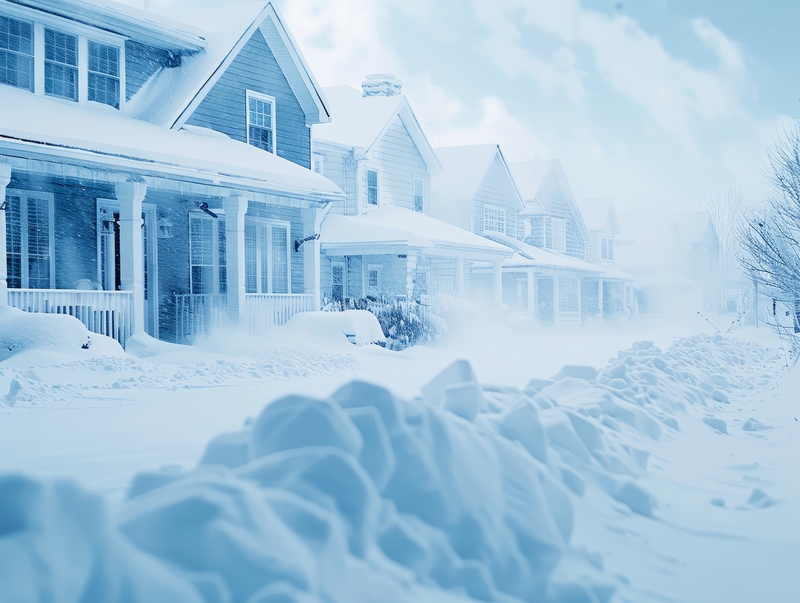
Yes, winter is in full swing. Frigid cold weather is making its way across the country, dropping temperatures and, in some states, heavy amounts of snow. Many homeowners are bracing for the impact that continuing inclement weather can have on their property.
So, have you taken all the necessary precautions to protect your home from the perils of a snowstorm?
When a blizzard hits, it can unload heavy amounts of ice and snow that can cause severe damage to your abode. To better prepare for a storm—or a bunch of them—take the following precautions.
1. Prevent frozen pipes
Frozen pipes can put your whole house out of commission, and they can be expensive to fix.
“To avoid frozen pipes, protect outdoor plumbing fixtures by disconnecting any hoses, shutting off the water to external sources, and insulating or covering all faucets,” says Brenda Bynarowicz, senior vice president of marketing at SimpliSafe.
She also recommends slightly opening indoor faucets for a steady water drip, since constant water flow through pipes can help prevent freezing or ice buildup.
2. Protect your roof
Before the storm hits your town, experts recommend that homeowners inspect their roof (safely from the ground) and look for missing shingles, degradation, and curling, which can all leave your home vulnerable to leaks.
Another way to protect your roof is to make sure your attic is evenly and sufficiently insulated.
“Proper insulation can help prevent ice buildup,” says Alex Pecora, director of product management, residential roofing at CertainTeed.
Pecora says snow on the roof should melt slowly and naturally as exterior temperatures increase. But improper insulation will allow warm air to escape through your attic and roof.
“If warm air is escaping from your attic, it can cause the snow to melt too quickly. Eventually, as the temperatures drop below freezing again, the water refreezes and creates an ice dam, which can cause damage to the attic, ceilings, and walls,” says Pecora.
An ice dam is a wall of ice that forms along the edge of the roof when heavy snow on the roof melts during the day and then refreezes overnight.
Before a storm hits, experts say it’s worth bringing in a professional to help seal up your attic if it’s drafty.
3. Clear gutters and downspouts
Gutters and downspouts should be regularly cleaned, but it’s critical to make sure they’re free of debris before a big storm.
“Clogged gutters prevent ice and melted snow from leaving the surface of the roof. If gutters have leaves and debris inside, meltwater can build up in the gutter trough and turn into ice,” says Mallory Micetich, a home expert at Angi.
Bynarowicz says cleaning gutters before a snowstorm can also help prevent ice dams from forming near gutter downspouts.
“More often than not, ice dams and clogged drains cause leaks into your home. Keeping gutters clear of debris will let runoff pass freely and avoid blockage,” says Bynarowicz.
4. Monitor home temperature
It’s freezing outside, but you’ll want to keep your home warm inside to protect your pipes from freezing and bursting.
“Maintaining your home’s temperature at a minimum of 65 degrees [Fahrenheit] or higher is crucial when facing low temperatures and winter storms,” says Bynarowicz.
If you’ll be out of your house for an extended time, experts recommend setting your thermostat to a minimum of 50 degrees to prevent the pipes from bursting.
You can also install a temperature sensor that will alert you when your home’s temperature drops below 41 degrees.
5. Watch for ice buildup
A little snow to make a snowman is nice, but a blizzard covering your whole front door and porch is downright dangerous.
“Ice can build up outside your front door, causing a dangerous and slippery surface,” says Bynarowicz.
Make sure to stock up on rock salt, portable heaters, and shovels, and keep an eye on the snow levels on your front porch to make sure you’re shoveling when needed.
“Try to stay on top of snow removal so that it doesn’t have time to clump together and turn to ice,” says Micetich.
For those who live in areas that get heavy snow, Micetich advises getting an annual snow removal contract that you can pay one set price for. This will ensure guaranteed service whenever it snows.
6. Chop dead branches
During a winter storm, trees can be your home’s worst enemy.
“Prepare for any snowstorm by removing visible debris from trees that could cause damage to your home’s exterior or vehicles, such as dead or low-hanging branches,” says Bynarowicz.
Stress from the elements can bring branches tumbling down, and bring down power lines with them, leaving your home disconnected from emergency services.
The more prepared you are, the easier it will be to get your family and home through winter unscathed.
Ana Durrani, Realtor.com

